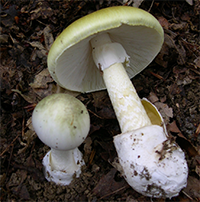The deadliest mushroom in the world is...
The Death Cap: "Amanita phalloides"
 | Amanita phalloides, commonly known as The Death Cap mushroom, are responsible for 90% of the world's mushroom-related fatalities1. The death cap can be easily mistaken for edible mushrooms such as the puffball and the paddy straw mushroom. In our Mushroom Identification courses, we teach you how to differentiate between these species to ensure that you and your family pick safely. |
|---|
The deadly toxic basidiomycete fungus Amanita phalloides, sometimes known as the death cap, is one of numerous species in the genus Amanita. A. phalloides, is widely dispersed throughout Europe but is now emerging in other regions of the world. In rare instances, the cultivation of non-native oak, chestnut, and pine species has resulted in the introduction of the death cap to new areas. The huge fruiting bodies (mushrooms), which often have a greenish cap and a white stipe and gills, develop throughout the summer and the fall. Since the colour of the cap can vary, particularly in white forms, it cannot be used as a trustworthy indicator.
If you would like to know what the top 10 deadliest mushrooms are click the link to see the full list. However, you need to be careful as there are quite a few look a like mushrooms which can be mistakenly misidentified. In regards to the Death Cap, there are some mushrooms that are often confused:
Caesar's mushroom (Amanita caesarea) - This mushroom is found in Europe and is often mistaken for the death cap due to its similar appearance. It is edible, but it is important to be able to accurately distinguish it from the death cap.
Straw mushroom (Volvariella volvacea) - This mushroom is widely cultivated and is often sold in markets. It can resemble the death cap, particularly when young, but it does not have the same distinctive white ring on the stem that is characteristic of the death cap.
Golden mushroom (Agaricus xanthodermus) - This mushroom is found in Europe and North America and can resemble the death cap when young. However, it has a distinctive odor and becomes yellow when bruised or cut, which can help to distinguish it from the death cap.
Honey fungus (Armillaria mellea) - This mushroom is found in many parts of the world and can resemble the death cap when young. However, it has a honey-colored cap and a distinctive ring on the stem that can help to distinguish it from the death cap.
It is important to note that these are just a few examples and that there are many other mushrooms that may resemble the death cap. If you are not an experienced mushroom hunter and are not able to accurately identify a mushroom, it is best to avoid consuming it.
References
1Amanita phalloides Mushroom Poisonings — Northern California, December 2016. Kathy T. Vo, MD, corresponding . Martha E. Montgomery, MD, S. Todd Mitchell, MD. MMWR Morb Mortal Wkly Rep. 2017 Jun 2; 66(21): 549–553. Published online 2017 Jun 2. doi: 10.15585/mmwr.mm6621a1. Accessed via: https://www.ncbi.nlm.nih.gov/pmc/articles/PMC5657817/
